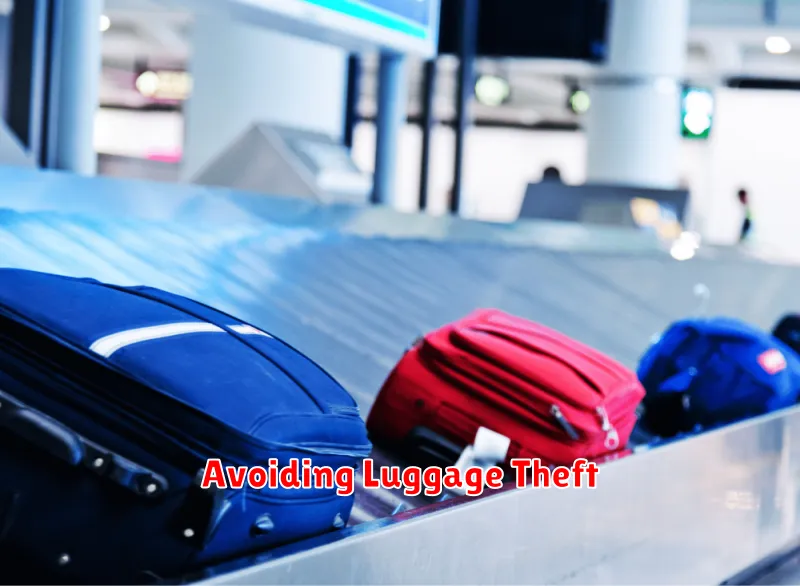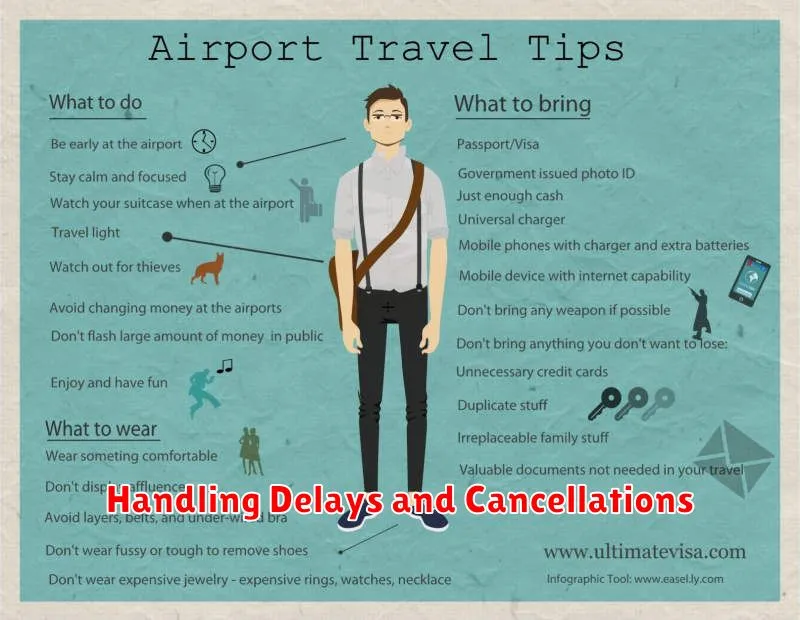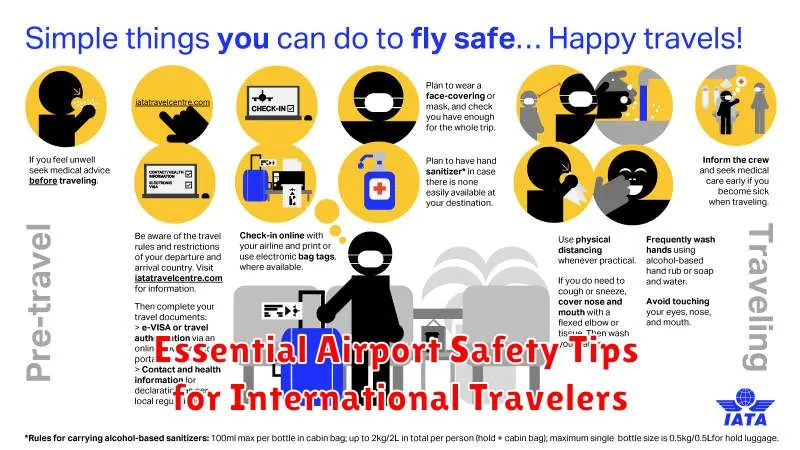Traveling internationally can be an exciting experience, but it’s crucial to prioritize safety, especially at the airport. This article covers essential airport safety tips for international travelers to ensure a smooth and secure journey. From navigating bustling terminals to protecting your valuables and personal information, we’ll equip you with the knowledge and strategies to stay safe and mitigate potential risks. Understanding these tips will not only provide you with peace of mind but also contribute to a more enjoyable travel experience. Whether you’re a seasoned globetrotter or embarking on your first international adventure, these airport safety tips are indispensable.
International airports present unique security challenges, and being prepared is key. We’ll delve into essential topics like safeguarding your passport, understanding customs regulations, and staying vigilant against common airport scams. This guide will also cover best practices for baggage security, navigating airport security checkpoints efficiently, and staying connected while abroad. By implementing these essential airport safety tips, you can focus on the excitement of your journey, knowing you’ve taken the necessary steps to ensure a safe and secure international travel experience.
Staying Aware in Busy Airports
Navigating a busy airport can be overwhelming. Awareness of your surroundings is crucial for a smooth and safe travel experience. Keep your belongings close, especially your passport and identification. Be mindful of announcements and signage changes, as gate information can be updated frequently. Avoid distractions like excessive phone use, and stay alert to potential security risks or suspicious activities. Report anything unusual to airport personnel immediately.
Personal safety should be a top priority. Be cautious of individuals who may be overly friendly or attempt to distract you. Don’t leave your luggage unattended, even for a short time. When using public restrooms or charging stations, be aware of your surroundings and avoid leaving valuables exposed. If traveling with children, ensure they stay within sight and know what to do if they become separated from you.
Planning ahead can significantly reduce stress and improve your airport experience. Arrive at the airport with ample time to check in, clear security, and locate your gate. Check your flight status regularly for any updates or delays. Familiarize yourself with the airport layout ahead of time, especially if you have connecting flights. By being prepared and staying aware, you can navigate the bustling airport environment with confidence and ease.
Dealing with Security Checks Smoothly
Airport security checks are a necessary part of modern travel. While they can sometimes be a bit of a hassle, understanding the process and being prepared can greatly streamline your experience. Arrive early to allow ample time for check-in, security, and reaching your gate. Have your boarding pass and identification readily available. Familiarize yourself with the prohibited items list to avoid delays and potential confiscation of belongings. By following these simple steps, you can minimize stress and contribute to a more efficient security process for everyone.
Once you reach the security checkpoint, be prepared to remove your shoes, belt, and any outer layers like jackets or sweaters. Place these items along with your carry-on bag in the provided bins. Electronic devices larger than a cell phone, such as laptops and tablets, will typically need to be removed from your bag and placed in a separate bin. Pay attention to the instructions given by Transportation Security Administration (TSA) officers, and cooperate with their requests. Moving efficiently through the line demonstrates consideration for fellow travelers.
After passing through the screening devices, collect your belongings promptly and proceed to your gate. Double-check that you have retrieved all of your items before leaving the security area. If you have any questions or concerns about the security process, don’t hesitate to ask a TSA officer for assistance. They are there to help ensure a safe and efficient travel experience for all passengers.
Avoiding Luggage Theft

Luggage theft is a common travel concern, but taking preventative measures can significantly reduce your risk. Always keep your luggage within your sight whenever possible. When you must leave it unattended, such as at a restaurant or check-in counter, try to position it so you can still observe it. Utilize TSA-approved locks on all your bags and consider wrapping your luggage in a distinctive cover or strap to both deter thieves and make it easier to identify on the baggage carousel. Inside your bags, avoid packing valuables such as expensive jewelry, electronics, or important documents. These items are best kept on your person or in a secure hotel safe.
When checking bags with an airline, ensure you have a secure luggage tag clearly displaying your name, address, and phone number. Consider adding a secondary tag inside your bag as well, in case the outer tag becomes detached. After retrieving your luggage from the baggage claim, double-check that it is indeed yours before leaving the airport. Thieves sometimes take similar-looking bags by mistake, and quickly realizing the error can help reunite you with your belongings.
If, despite your best efforts, your luggage is stolen, immediately report it to the appropriate authorities. For airlines, this means contacting the airline’s baggage claim department. Provide them with a detailed description of your bag and its contents, along with your contact information. File a police report as well, especially if your luggage contained valuable items. A police report is often necessary for insurance claims. Consider investing in travel insurance that covers lost or stolen luggage to mitigate the financial impact of such an event.
Using Airport Wi-Fi Safely
Airport Wi-Fi is a convenient amenity for travelers, but it’s crucial to understand the security risks and take precautions. Public Wi-Fi networks are often unsecured, meaning your data isn’t encrypted and could be intercepted by malicious actors. Avoid accessing sensitive information, such as online banking or email accounts that contain personal details, while connected to airport Wi-Fi.
Enhance your security by utilizing a Virtual Private Network (VPN). A VPN creates an encrypted tunnel for your data, shielding it from prying eyes. This is especially important when accessing websites that require login credentials. Additionally, ensure your device’s firewall is enabled and your operating system is up-to-date with the latest security patches. These steps help protect against malware and other cyber threats.
Be mindful of the websites you visit and the links you click while on public Wi-Fi. Avoid clicking on suspicious links or pop-ups. If you need to access sensitive information, consider using your mobile phone’s data connection as a safer alternative. By taking these precautions, you can enjoy the convenience of airport Wi-Fi while minimizing the risks to your online security.
Watching for Fake Officials or Scammers
Be wary of unsolicited contact. Legitimate government officials and businesses rarely initiate contact through unexpected phone calls, emails, or text messages. They typically won’t demand immediate payment or personal information like Social Security numbers or bank details through these channels. If you receive a suspicious communication claiming to be from an official source, independently verify their identity by contacting the organization directly using publicly available contact information.
Look for red flags. Scammers often use high-pressure tactics, create a sense of urgency, or threaten legal action to coerce victims. They may promise prizes, refunds, or other incentives that seem too good to be true. Grammatical errors, misspellings, and unprofessional language in emails or letters are also strong indicators of a scam. Be cautious of requests for unusual payment methods, such as gift cards, wire transfers, or cryptocurrency.
Protect yourself. Never share sensitive information with anyone you haven’t verified. If you suspect you’ve been targeted by a scammer, report the incident to the appropriate authorities, such as the Federal Trade Commission (FTC) or your local police department. Regularly monitor your financial accounts for unauthorized activity and consider placing a fraud alert or security freeze on your credit reports.
Handling Delays and Cancellations

Travel disruptions such as delays and cancellations can be frustrating. It’s important to be prepared and know your rights. In the event of a delay, check with the airline or transportation provider for updates and options. Stay informed about the reason for the delay and the estimated departure/arrival time. Keep your travel documents, such as your ticket and identification, readily available.
If your travel is cancelled, contact the airline or transportation provider immediately to discuss your options. These may include rebooking on the next available flight or receiving a refund. Be proactive in understanding your entitlements, which may vary depending on the reason for the cancellation and the specific terms and conditions of the carrier. For example, you may be entitled to compensation for meals, accommodation, or alternative transportation depending on the circumstances.
Travel insurance can provide additional protection in the event of delays or cancellations. Review your policy carefully to understand the coverage offered and any required procedures for filing a claim. Be sure to document all expenses incurred due to the disruption, such as receipts for meals and accommodation, as these may be required for reimbursement.
What to Do in an Emergency
In any emergency, it’s crucial to remain calm and assess the situation. Quickly identify the immediate danger, whether it’s a fire, medical emergency, or natural disaster. Your first priority is to ensure your safety and the safety of others around you. If possible, move to a safe location away from immediate harm. Once safe, call for help by dialing the appropriate emergency number for your location. For example, in the United States, dial 911. Clearly and concisely explain the situation, providing your location and the nature of the emergency.
If someone is injured, provide basic first aid if you are trained and it is safe to do so. Do not attempt anything beyond your skill level. Focus on keeping the person calm and comfortable until professional help arrives. If the situation involves a fire, evacuate the building immediately and do not attempt to re-enter. If a natural disaster is imminent or occurring, follow established evacuation procedures or seek shelter as instructed by authorities.
After the immediate danger has passed, cooperate with emergency personnel and follow their instructions. Provide any necessary information they request and be mindful of the ongoing situation. Remember that staying informed and prepared can significantly impact your ability to navigate emergencies effectively. Consider having a basic emergency kit and a plan in place for various scenarios.

